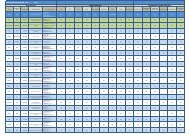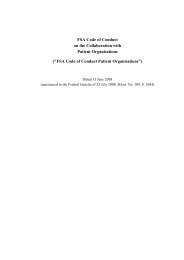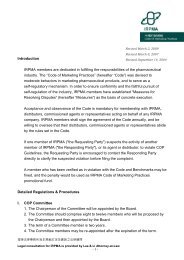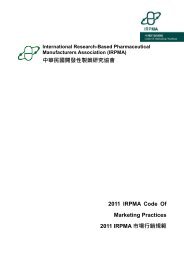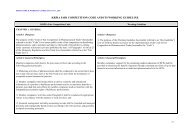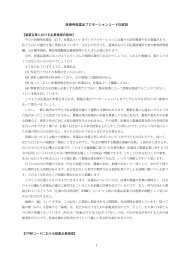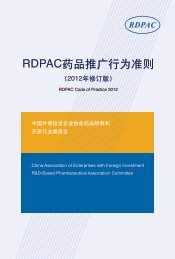Pharmaceutical Products and Chemical Intermediates ... - IFPMA
Pharmaceutical Products and Chemical Intermediates ... - IFPMA
Pharmaceutical Products and Chemical Intermediates ... - IFPMA
Create successful ePaper yourself
Turn your PDF publications into a flip-book with our unique Google optimized e-Paper software.
CHAPTER 3<br />
Estimates of Current U.S. Trade in the<br />
<strong>Products</strong> Included in the Existing<br />
<strong>Pharmaceutical</strong> Appendix <strong>and</strong> the Proposed<br />
Additions to the Appendix<br />
Total trade in products from HTS chapter 30 <strong>and</strong> HTS headings 2936, 2937, 2939, <strong>and</strong><br />
2941 was valued at more than $102.0 billion in 2009, an increase from more than $97<br />
billion in 2008. Much of the increase was the result of growth in U.S. exports in 2009. As<br />
the domestic market for chemicals started slowing in early 2008, many companies<br />
focused on foreign markets. 1 But by late 2008, these markets started slowing, too. In<br />
2009, imports of many of these products increased, particularly those classified under<br />
chapter 30 <strong>and</strong> those tracked by the “K” special-rate-of-duty code, due in most part to<br />
increases in imports from Germany, Singapore, <strong>and</strong> the United Kingdom; related-party<br />
trade also played a role as many of the companies are multinational. Looking at the trade<br />
data in more detail for 2008 <strong>and</strong> 2009, the share of total trade accounted for by chapter 30<br />
increased from 89 percent to 93 percent <strong>and</strong> the shares of each of the four specified HTS<br />
headings of chapter 29 declined. U.S. imports <strong>and</strong> exports of products classified in<br />
chapter 30 increased over the two years. Much of the trade in pharmaceuticals, including<br />
imports into the U.S. market, is in products that are shipped to the intended market for<br />
final formulation <strong>and</strong>/or packaging to meet domestic regulations. Table 3.1 provides<br />
values of U.S. imports for consumption, domestic exports, <strong>and</strong> the trade balance for HTS<br />
chapter 30 <strong>and</strong> HTS headings 2936, 2937, 2939, <strong>and</strong> 2941. 2<br />
U.S. imports of products currently listed in the <strong>Pharmaceutical</strong> Appendix <strong>and</strong> tracked<br />
using the “K” special-rate-of-duty code were valued at approximately $23.4 billion in<br />
2008 <strong>and</strong> $25.2 billion in 2009; 3 the ad valorem equivalent tariff rate for these products<br />
would have been 6.2 percent in 2009 if they had not received duty-free treatment. 4 Tables<br />
3.1 <strong>and</strong> 3.2 present trade data for the products imported under the <strong>Pharmaceutical</strong> Zerofor-Zero<br />
Initiative in 2008 <strong>and</strong> 2009. The total value of U.S. imports under the<br />
<strong>Pharmaceutical</strong> Agreement in 2009 ($85.2 billion) can be obtained by adding the value of<br />
1<br />
USITC, Shifts in U.S. Merch<strong>and</strong>ise Trade 2008, 2009, CH-1–CH-4.<br />
2<br />
As noted in chapter 2 of this report, the subheadings in HTS chapter 30 <strong>and</strong> headings 2936, 2937,<br />
2939, <strong>and</strong> 2941 are duty-free except for subheadings 3006.70.00, 3006.91.00, <strong>and</strong> 2941.20.10. Imports <strong>and</strong><br />
exports for items in these three subheadings are included in the values in table 3.1. In 2009, the value of U.S.<br />
imports for consumption came to $2.5 million for 3006.70.00, $64.8 million for 3006.91.00, <strong>and</strong> $0.4 million<br />
for 2941.20.10. Domestic exports came to $21.9 million for 3006.70.00, $137.0 million for 3006.91.00, <strong>and</strong><br />
$0.3 million for 2941.20.10 in 2009.<br />
3<br />
Equivalent export data are not available because export data are generally aggregated at a higher level<br />
than import data <strong>and</strong> because the preference program <strong>and</strong> tariff rates only apply to imports.<br />
4<br />
The ad valorem equivalent tariff rate for products in the <strong>Pharmaceutical</strong> Appendix was calculated by<br />
dividing the sum of duties that would have been collected in 2009 if the products had not received duty-free<br />
treatment by the total value of imports for the products in that year.<br />
3-1



